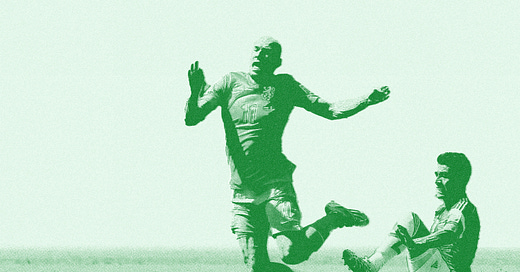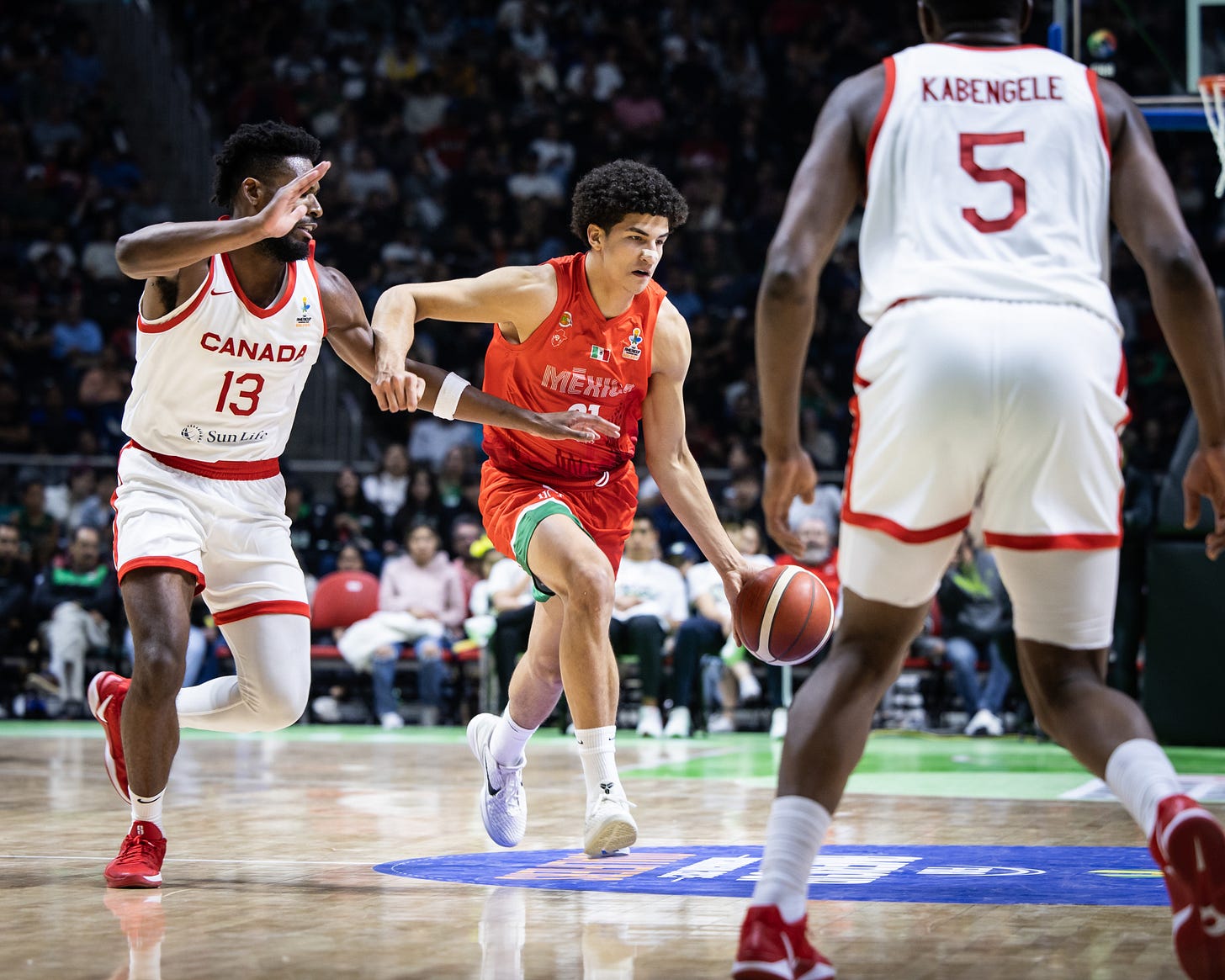Generation MX and Why Over a Decade Later "No Era Penal" Remains True
A new crop of talent emerges for the Mexican men's national team at FIBA AmeriCup qualifiers, but bad luck strikes for the struggling sports nation yet again
I’ve been living in Mexico with my family for the past six months now, adjusting to its frenetic, freeing rhythms and constantly reminding myself about the privilege of being able to move our bodies across imperially dictated lines without consequence. It’s both a miracle and a malediction to be from two places, and yet from neither. I won’t lie to you, though: most mornings I wake up in Mexico feeling a jolt of liberation and vibrancy (in ways that feel increasingly evasive in the United States) and for attaining that, I am fucking grateful.
Of course, I’ve very much kept many of my “American” habits and desires in orbit, from the way I dress in my North Face bubble jacket and Timberland boots on a rainy day, to the Nintendo Switch I lug around during my travels, exploring Japanese RPGs in English as the craggy, mountainous sceneries between Veracruz and Puebla blur past my window on the bus. Mexico is both a place I now live in, and a place that has always lived in me — as half-remembered memories, childhood excursions, the nick of fire ants and sting of wasps, the soccer matches that constantly aired on my immigrant dad’s television, my abuela’s scolding, family trips on winding roads lined with banana plantations, all of it. One cannot shed the past, nor should they.
That’s my longwinded way of saying that in this new dimension I’ve inhabited, I’ve done my best to maintain myself in a way that feels true to my needs, while keeping my antennas up to receive unknown signals that may be transmitted. Somehow, for cosmic reasons unknown, basketball helps me do that.
Admittedly, my younger self would be ashamed at how little I’ve been able to genuinely keep up with the NBA on a nightly basis (how could I?). But whenever I can string together a series of uninterrupted minutes, I do catch segments of a game on NBA League Pass. And maybe most enticingly, I’ve started to watch Mexican basketball more than ever as a mandatory supplement for my basketball-starved spirit.
As I’ve written about ad naseam, basketball has risen as one of Mexico's most promising athletic circuits, accelerating like a runaway fast break with an intranational league expansion and increasing viewership in recent years. While the national team and its federation are imperfect, there is a palpable sense of attention and anticipation for Mexico's hopes on the basketball court. With the addition of the Mexico City Capitanes to the NBA G League in 2019 and the emergence of players of Mexican descent in the past few NBA seasons, including former NBA champion Juan Toscano-Anderson and former UCLA standout Jaime Jáquez Jr. of the Miami Heat, basketball fanaticism has infiltrated the general Mexican consciousness in ways that once was only reserved for soccer and baseball.
Within that swirling constellation of sports stardom in the Spanish-speaking republic, a handful of Mexican hoopers have shone from the Liga Nacional de Baloncesto Profesional in Mexico to the National Basketball League in Australia. The national team represents a new hope, to borrow from one George Lucas, in what this nation’s bucket-getting future might hold. And from what I’ve seen of Mexican-born basketball players in the past millennia, this could easily be the most talented team the country has ever assembled — strengthened by a veteran foundation of Fabian Jaimes and Israel Gutierrez, and bolstered by its necessary undergirding of youth in Karim López, Gael Bonilla, and Moises Andriassi.
Let me be clear: Despite having more star potential than ever (with López, in particular, drawing attention as a surefire NBA Draft prospect who has surpassed his rookie class as a member of the NBL Next Stars program with the New Zealand Breakers), Mexico has many moons to traverse before being considered a contender. For all of the hype, the national team has fared with mixed results, and they are far from the most successful team Mexico has ever fielded. For now.
That title may belong to the 2013 squad, in which Mexican basketball legend Gustavo Ayón (who was voted MVP of the FIBA AmeriCup Championship that year) captained Mexico to a surprising gold medal victory against favorite Puerto Rico. Mexico was a late addition to that year's tournament, replacing Panama, which was disqualified and suspended from international play due to internal management issues. Ayón and Mexico defeated the host nation Venezuela, then followed that up by topping Paraguay, the Dominican Republic, and a perennially competitive Argentina in Mexico’s first and only FIBA AmeriCup. The unexpected victory led to Mexico's invitation to the Basketball World Cup for the first time in two decades (at the moment), where they defeated Korea and Angola before falling to a juggernaut United States in the second round. Besides those runs, other notable achievements in Mexican basketball history include winning a bronze medal at the 1936 Summer Olympics and finishing in the top five in 1948 and 1968 (as host country). The team also boasts a handful of victories against its North American neighbor in the flag-waving United States, most recently in 2018, 2021, and 2022.
And yet, despite experiencing such inconsequentiually short-lived successes in the past, the nation has never fielded a young core with as much sheen and allure as this current generation. “Aura” some might call it. The aforementioned López, a 17-year-old forward who stands 6'0" (2.06 m), became the youngest player in NBL history to record a double-double, surpassing high-profile NBA players who preceded him in the Australian league, not limited to LaMelo Ball, Alex Sarr, and Josh Giddey. ESPN predicts Lopez is "one of the top prospects" in the 2026 NBA Draft, which would make him the first Mexican-born player to be so highly coveted (Eduardo Nájera is the only Mexican-born player to ever be drafted into the NBA, selected 38th overall in the second round by the Houston Rockets; Horacio Llamas, Ayon, and Jorge Gutiérrez all went undrafted before joining the NBA's eternal phalanx).
In addition to López, Gael Bonilla has showcased his skills as a notable up-and-comer from Ecatepec — a working class province on the northern rim of Mexico City’s urban sprawl — by helping to secure a national championship as a key member of the Diablos Rojos del México last season. Prior to the Pingos (the storied Mexican baseball organization that turned itself into a basketball powerhouse as the latest team in Mexico's LNBP) the 21-year-old played in Spain as a member of F.C. Barcelona. Beside him, 24-year-old Moisés Andriassi, who previously played with the Jalisco Astros and the NBA G League Capitanes, brings a youthful game off the bench.
With so much on the line, this current Mexican national team was in the spotlight earlier this year during the qualifiers for the FIBA AmeriCup (a quadrennial tournament held between teams throughout the Western Hemisphere and taking place in Nicaragua this year). Unfortunately for this Generation MX, the team fell short, failing to qualify in a quintessentially Mexican fashion: by a small point differential.
Mexico finished with the second-most wins in the qualifiers among the sixteen nations that competed in this year's global qualifiers. Perhaps due to El Tri's eternal misfortune (NO ERA PENAL), they fell victim to the group of death, in which Canada (the second-highest-ranked team in the entire competition), the Dominican Republic (which won the same number of games as Mexico), and Nicaragua (which automatically qualified as the host nation) surpassed Mexico. In any other group, Mexico would have objectively advanced, as it earned one of the highest points totals in the qualifiers and won more games than most. In their final game, they defeated Canada, the top-ranked team, but Nicaragua (a winless team) took Mexico's place and automatically proceeds as the host nation, per the rules of any international competition where the host team always moves forward no matter what (NO ERA PENAL CHINGADA MADRE).
Here are some numbers on how it all went down at the 2025 FIBA AmeriCup: Pako Cruz, a veteran Mexicano playing abroad in Turkey's Basketbol Süper Ligi, led his team in efficiency and points (Bonilla ranked second in both categories). James led the rest of his teammates with the most rebounds per game, while Bonilla's teammate and recent LNBP champion, J.J. Ávila, tied Cruz for the most assists per game. Indeed, it was the experience of Mexico's vets (including Gutiérrez, Gabriel Girón, and Paul Stoll) that set the tone, with the younger players receiving limited PT. López arguably bagged the entire tournament's highlight with a Michael Jordan-esque dunk flight over a Nicaraguan defender from the baseline, displaying the athleticism that has basketball scouts and general managers gleefully rubbing their palms together (López otherwise had a “meh” tournament, largely because he didn’t get as much time on the court).
As is always the case with El Tri, Mexico failed to advance despite a statistically positive set of wins against international competition in one of López’s first campaigns on the A-team. The next few years will reveal if this group of Mexican ballers can develop into its most successful, as predicted, or if, inevitably, the pendulum of chance will ultimately swing against Mexico’s favor once more.







